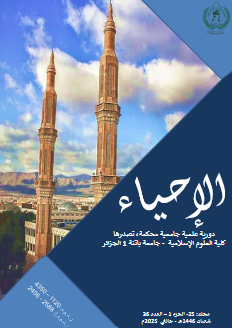Cultural life in Algeria during the Ottoman era and its relationship with the capitals of the East and the West during the centuries 1139 AH-1727 AD / 1245 AH-1830 AD
DOI:
https://doi.org/10.59791/ihy.v25i1.4805Keywords:
cultural, mosques, schools, endowment institutions, Al-Haramain Foundation, the Ottoman era, the Holy Qur’an, the mosque, Andalusia, the Levant, the TreasuryAbstract
During the Ottoman era, the people of the country carried the banner of religion and science in Algeria. Among them were scholars, jurists, and hadith scholars. The Holy Qur’an and the Prophet’s hadith were the source of all the knowledge that was taken in various religious institutions. You could hardly find a village or city devoid of it, as students came to it willingly. Some of them were involved in the acquisition of religious sciences, and even Algerian scholars had an effective role in the East and West through teaching and writing in various sciences, and several cities became famous for science and jurisprudence, such as: Algiers, Tlemcen, Oran, Mazouna and others.
Charities, donations, and other donations played an effective role in the continuation of these endowments, as the people donated their money to various endowment institutions, such as houses, mosques, corners, shops, and others in the city of Algiers and outside it. Public and private libraries also contributed to the promotion of cultural life. In Algeria, where schools, mosques, corners, and shrines were found in the largest cities, which contained the rarest works and works brought by scholars from the East, the villagers, and even from Andalusia, and even the programs adopted in these educational institutions became very similar to Kairouan, and Zitouna, And Al-Azhar.
Downloads
Published
How to Cite
Issue
Section
License

This work is licensed under a Creative Commons Attribution-NonCommercial-NoDerivatives 4.0 International License.





